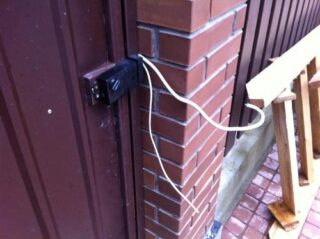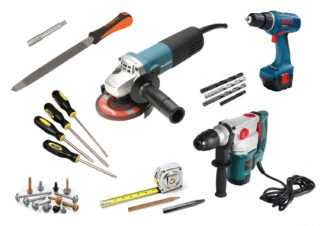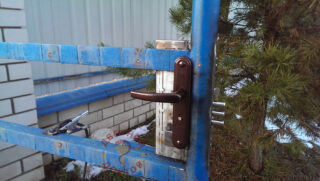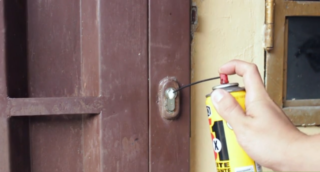Doors without locking devices are just a point of access to the fenced area and do not perform protective functions. Self-installation of the lock on the gate is a simple procedure, if you follow the basic rules and be careful.
Purpose and requirements for the lock

The purpose of the wicket lock is to securely fix the door in the closed position and protect it from the entry of unauthorized persons.
The gate in the fence only partially resembles the entrance doors to a house or apartment. The operating conditions are strikingly different, therefore the range of locking devices varies greatly.
There are several requirements for outdoor locks:
- reliable protection against moisture, which causes corrosion and seizure in frost when structural elements freeze;
- the minimum number of moving parts in the secret mechanism;
- anti-vandal and anti-corrosion design of the case.
Failure to comply with at least one of the points may result in operational difficulties.
Varieties of locks

Mortise locks are distinguished by several criteria, which must be taken into account when buying a device.
The choice is influenced by:
- opening direction;
- type of secret mechanism;
- drive method;
- constipation design.
The first parameter is especially important to take into account in mechanisms with a latch, so that it automatically fixes the canvas when closing. There are models that allow you to independently change the position of the fixing tab. To do this, open the case and perform simple manipulations.
In mortise locks, rack, lever, cylinder and code types of secrets are most often used.
The first type is easy to select, needs regular lubrication - due to large keyholes, it is prone to moisture ingress and freezing during daytime thaws and night frosts. At the same time, the restoration of working capacity will not cause difficulties - it is enough to remove the bolt bars, clean and lubricate.
Lever mechanisms are the most protected from key selection and breaking by folding, they are the best option.
Cylinder secrets are most susceptible to winter freezing, as they contain many small moving parts and microscopic springs.
Combination locks are stable, the combination can be changed independently at any frequency.
Sometimes a radio-wave method of controlling the actuator is used for gates, which excludes the presence of keys, but requires connecting a backup power supply.

The deadbolt drive can be:
- mechanical - a key for the bolt, a handle that opens the latch, pressing the selected code;
- electromechanical, when the bolt is driven by an electromagnet;
- electromagnetic, when the lock is attracted to the striker.
Mechanical locks are reliable, but do not allow remote control; they cannot be used as part of ACS (access control and management systems).
When the power is turned off, the electromechanical devices remain in the closed state, but they are opened with a key and a cylinder mechanism. This is the best option for a wicket door, since the lock can be operated manually, with an electronic key or remotely.
For electromagnetic locks, an uninterruptible power supply unit is required - in the absence of voltage, the electromagnet stops working. At the same time, there are no moving parts on such locks, which has a positive effect on work in any weather conditions.
Installation materials and tools

To install the lock on a corrugated gate, you need a minimum set of tools and materials:
- a drill with a set of drills for making slots for the lock body and striker plate, drilling holes for fastening screws;
- grinder or file for sampling metal of a slot;
- square with markings, tape measure, marker;
- a screwdriver with a sting suitable for hardware;
- welding machine with a mask for the manufacture of a protective box.
From additional materials that are not included in the kit, a sheet of metal of the required size for the casing is selected, paint and a brush are purchased.
Step-by-step instruction

You can do the installation of the lock on the gate with your own hands by following the simple step-by-step instructions:
- At a height of about 1 m from the ground, it is necessary to make markings under the body. Having attached the lock to the profile, mark the lower and upper edges, the sides.
- Holes are drilled in the corners of the marked rectangle. This makes it easier to work with a grinder without damaging excess metal.
- An angle grinder makes a groove hole in the profile pipe. The corners are sharpened with a file. Before work, it is advisable to dismantle the profiled sheet so as not to damage the protective layer and for the convenience of work.
- Insert the lock into the groove and mark the attachment points. A hole is drilled 0.3 mm less than the diameter of the fastening screw. Another option is to cut the threads for the screws.
- Applying the lock body to the profile, mark the places for the secret mechanism or key slots. Holes of the required diameter are drilled, or a keyhole is cut for lever or rack keys. It is important to first study the detailed instructions of the manufacturer. It often contains a template to help with markup.
- The lock is fastened, if necessary, the cylinder mechanism is installed.
- Having closed the gate, they mark the places where the bolt on the door jamb will enter.
- Cut out the grooves, check that the bolts go freely into the holes when closing. A file is used to achieve an exact match.
- Install a decorative strip on the jamb of the wicket.
- Having made measurements, the plates are cut out for the manufacture of a protective casing. The plates are welded, after removing the lock, be sure to protect or remove the profiled sheet.
- For wickets framed by a euro-frame, the casing is protected from all sides.
- After welding, the casing and the profile tube are painted to prevent corrosion.
- After installing all the elements, the decorative elements are installed from the side of the yard and street.
The tie-in is considered complete after checking the functioning of the lock in a fully assembled state Disadvantages are eliminated by adjusting or adjusting the holes in the jamb of the wicket.
Exploitation

Daily operation is not difficult. It is important to monitor the operation of the mechanisms and, if a malfunction occurs, to carry out simple manipulations.
Once every 2-3 months or if necessary, clean the mechanisms and lubricate them. A malfunction is indicated by squeaks or increased forces required to open / close.
After a thaw, if the forecast promises night frosts, it is advisable to fill the well with a liquid lubricant suitable for operation at subzero temperatures. An alternative option in case of a sharp drop in temperature is to open / close the lock several times to prevent the formation of ice.
In the event of a frost jam, you can use a household hairdryer or liquid defrosters. Do not try to open a frozen locking device using excessive physical force.A broken key will cause the replacement of the secret mechanism, which is equal in value to half of the lock.
Installing mortise locks on a metal profile gate is a feasible task for a home craftsman. A minimum of tools and skills are required. Correctly chosen lock, accuracy in work, timely maintenance is a guarantee of long and trouble-free operation of the mechanism.








